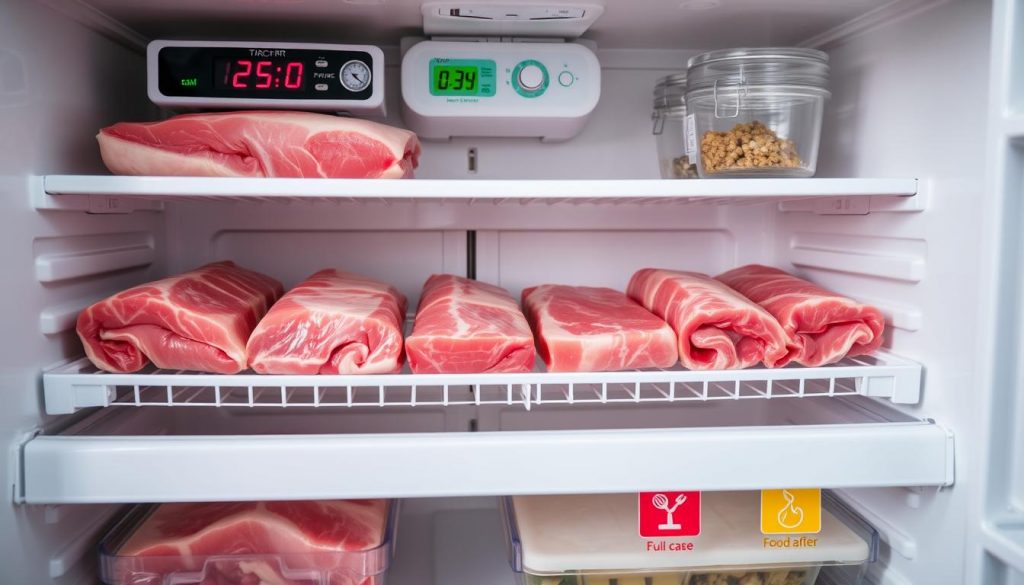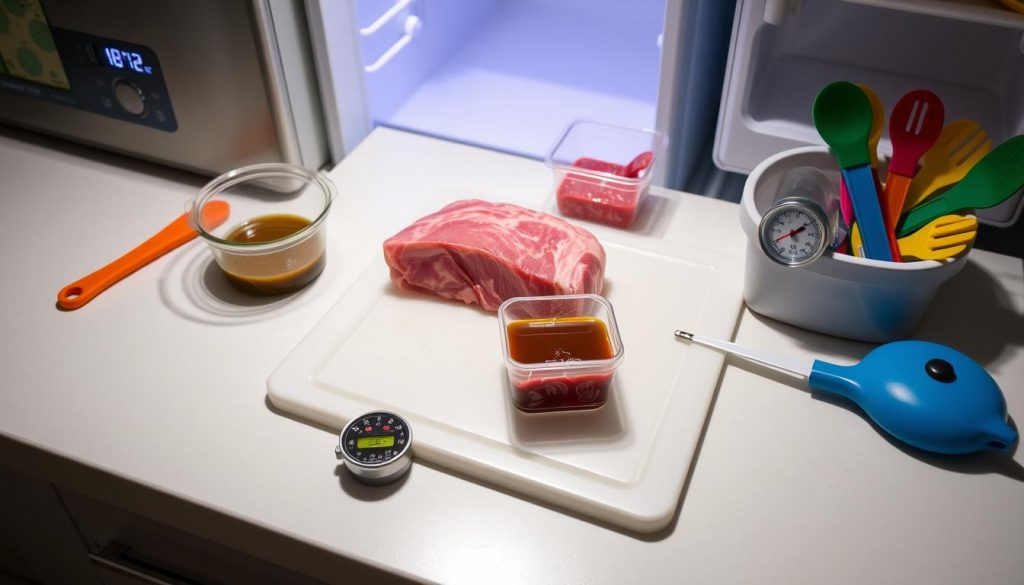Fresh raw pork is essential for tasty meals and safe eating. This guide will help you store pork properly. We’ll cover refrigeration tips and how to spot spoiled meat.
Proper meat storage is crucial for great cooking. We’ll explore the best ways to keep pork safe and fresh. Our aim is to help you enjoy pork dishes without health risks.
Storing pork correctly keeps it safe and tasty. We’ll discuss how long raw pork stays fresh in your fridge. You’ll also learn expert tips for handling this versatile meat.
Key Takeaways
- Raw pork has a limited shelf life in the refrigerator
- Proper storage techniques are essential for food safety
- Temperature control is crucial for maintaining pork freshness
- Recognizing signs of spoilage helps prevent foodborne illness
- Freezing can extend the storage life of raw pork
- Safe handling practices are vital when working with raw meat
Understanding Raw Pork Storage Basics
Proper raw pork storage is key for food safety and quality. Let’s look at how to keep your pork fresh and safe to eat.
Temperature Requirements for Safe Storage
Your fridge’s temperature is crucial for preserving raw pork. Set it at or below 40°F (4°C) to slow bacterial growth. Store pork in the coldest part, usually the back of the bottom shelf.
Importance of Proper Packaging
Good packaging extends pork’s shelf life. Use airtight containers or wrap pork tightly in plastic or foil. This stops air exposure and prevents cross-contamination with other foods.
Signs of Fresh Pork
Knowing fresh pork signs helps ensure safe meat consumption. Here’s what to look for:
- Color: Fresh pork should be pink or reddish-pink
- Texture: Firm to the touch, not slimy or sticky
- Smell: Mild, with no strong or unpleasant odors
These storage basics help keep your pork fresh and safe. Always check for spoilage before cooking and eating pork.
How Long Does Raw Pork Last in the Fridge
Knowing pork shelf life is key for safe and tasty meals. This guide helps you store raw pork correctly in your fridge. Follow these tips to keep your pork fresh and safe to eat.
Ground Pork Storage Timeline
Ground pork needs extra care due to its large surface area. Keep it at 40°F (4°C) or below. Use within 1-2 days for the best quality and safety.
Pork Chops and Roasts Shelf Life
Proper storage extends the life of pork chops and roasts. They can last 3-5 days in the fridge. Wrap them tightly or use airtight containers to keep them fresh.
Marinated Pork Storage Guidelines
Marinated pork adds flavor but shortens storage time. Use it within 2-3 days for best results. Marinades can change the meat’s texture over time.
| Pork Type | Refrigerator Storage (40°F or below) | Freezer Storage (0°F or below) |
|---|---|---|
| Ground Pork | 1-2 days | 3-4 months |
| Pork Chops | 3-5 days | 4-6 months |
| Pork Roasts | 3-5 days | 4-6 months |
| Marinated Pork | 2-3 days | 3-4 months |
These timelines work best with proper storage. Always check for signs of spoilage before cooking. Following these tips ensures safe and delicious pork dishes.
Recognizing Spoiled Pork
Spotting spoiled pork is vital for food safety. Learn the key signs to avoid eating harmful meat. This guide will help you identify spoiled pork easily.
Visual Indicators of Spoilage
When examining raw pork, watch for these spoiled pork signs:
- Slimy or sticky surface
- Mold growth
- Unusual dark spots
Smell and Texture Changes
Your nose can detect meat spoilage. Fresh pork should have a mild, slightly sweet scent. A sour or ammonia-like odor indicates spoilage.
The texture should be firm and slightly moist. Avoid pork that feels mushy or overly dry.
Color Changes to Watch For
Pork discoloration is a key spoilage indicator. Fresh pork typically has a pinkish-red color. Be wary of these color changes:
| Color | Indication |
|---|---|
| Grayish-brown | Beginning to spoil |
| Green or black | Severe spoilage |
| Iridescent sheen | Possible bacterial growth |
When unsure, it’s safer to throw out the pork. Don’t risk getting sick from bad meat. Trust your senses when checking meat quality.
Best Practices for Storing Raw Pork
Proper storage keeps pork safe and tasty. Here are key tips to keep your pork fresh. These methods will help you store pork like a pro.

Wrap raw pork tightly in plastic wrap or foil. This stops air and germs from touching it. For extra care, put wrapped pork in a sealed box or bag.
Keep pork on the bottom shelf of your fridge. It’s the coldest spot there. Store raw pork away from ready-to-eat foods to avoid spreading germs.
Follow these rules for the best pork storage:
- Set your refrigerator temperature to 40°F (4°C) or below
- Store ground pork for 1-2 days
- Keep pork chops and roasts for 3-5 days
- Use marinated pork within 2-3 days
To store pork longer, freeze it. Wrapped pork can last up to 6 months frozen. Thaw frozen pork in the fridge, not at room temp.
| Pork Cut | Refrigerator (40°F or below) | Freezer (0°F or below) |
|---|---|---|
| Ground Pork | 1-2 days | 3-4 months |
| Pork Chops | 3-5 days | 4-6 months |
| Pork Roast | 3-5 days | 4-6 months |
| Marinated Pork | 2-3 days | 3-4 months |
These storage tips will keep your pork fresh. Follow them to enjoy safe, tasty pork every time.
Freezing Raw Pork: Extended Storage Solutions
Freezing pork helps keep it fresh longer. Let’s look at how to freeze pork properly and safely thaw it later.
Proper Freezing Techniques
Wrap pork tightly in freezer paper or plastic wrap. Place it in a freezer-safe bag and remove air. Label the package with the date and cut type.
Freezer Storage Duration
Frozen pork lasts for months at 0°F (-18°C) or below. Ground pork stays fresh for 3-4 months. Pork chops and roasts can be stored for 4-6 months.
For best quality, use frozen pork within these time frames.
Thawing Methods and Safety
Safe thawing is key when preparing frozen pork. Here are the best ways to thaw:
- Refrigerator thawing: Place frozen pork in the fridge for 24 hours per 5 pounds
- Cold water thawing: Submerge sealed pork in cold water, changing water every 30 minutes
- Microwave thawing: Use for immediate cooking only
Never thaw pork on the counter. This can cause harmful bacteria to grow. Cook thawed pork within 1-2 days for best taste and safety.
Food Safety Guidelines for Handling Raw Pork
Safe handling of raw pork prevents foodborne illnesses. Let’s explore key practices for a clean kitchen and safe meals. These tips will help you handle pork safely.
Cross-contamination Prevention
Use separate cutting boards for raw pork and other foods. Clean all surfaces and utensils after contact with raw meat. This simple step maintains kitchen hygiene effectively.

Kitchen Hygiene Practices
Wash hands with soap and warm water before and after handling raw pork. Regularly clean countertops, sinks, and appliances to keep your kitchen spotless. These habits form the basis of good kitchen hygiene.
Safe Temperature Handling
Meat temperature is vital for food safety. Use a meat thermometer to check pork’s internal temperature. Whole cuts should reach 145°F (63°C), while ground pork needs 160°F (71°C).
| Pork Cut | Safe Internal Temperature |
|---|---|
| Whole cuts (chops, roasts) | 145°F (63°C) |
| Ground pork | 160°F (71°C) |
Following these guidelines ensures safe and delicious pork dishes. Proper pork handling starts with awareness and ends with a satisfying meal. Enjoy your pork safely!
Common Mistakes in Pork Storage
Pork storage errors can lead to serious health risks. Let’s explore common mistakes and how to avoid them. Proper storage ensures meat stays fresh and safe to eat.
Keeping raw pork on the top shelf is a major refrigeration error. This increases the risk of drips contaminating other foods. Store raw pork on the bottom shelf in a sealed container.
Leaving pork at room temperature for too long is another common mistake. Never let raw pork sit out for more than two hours. In warm rooms, reduce this time to one hour.
- Storing pork in its original packaging for extended periods
- Neglecting to check and maintain proper fridge temperature
- Thawing pork on the counter instead of in the refrigerator
Storing marinated pork for too long is a frequent error. Even in marinade, raw pork shouldn’t be kept in the fridge beyond 5 days. Label containers with storage dates to keep track.
“Proper storage is key to maintaining pork quality and safety. Don’t let simple mistakes compromise your health or meal quality.”
Avoiding these storage errors ensures pork stays fresh and safe. When in doubt, it’s better to discard questionable pork. Your health is worth more than a potentially spoiled piece of meat.
Tips for Maximizing Pork Freshness
Fresh pork is essential for a tasty meal. Let’s explore ways to keep pork fresh from store to plate.
Optimal Refrigerator Placement
Store pork on your fridge’s bottom shelf. It’s the coldest spot and prevents juices from dripping onto other foods. Good fridge organization is vital for food safety and pork freshness.
Container Selection Guidelines
Use airtight containers or resealable plastic bags for raw pork. These keep meat fresh and contain odors. Glass containers work well too, offering a clear view inside.
Shopping and Transport Tips
Get pork last during your grocery run. Use insulated bags to keep it cool on the way home.
Refrigerate or freeze the pork immediately after arriving home. These steps help preserve pork quality and safety.




